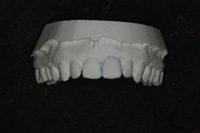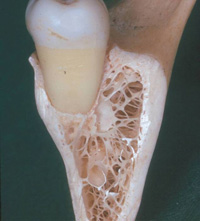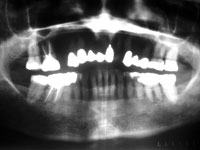There is evidence suggesting that hypertension affects nearly 50 million Americans.1 A study reported by Vasan et al,2 which followed 6,000 patients over a period of several years, determined that individuals with high normal blood pressure were two to three times more likely to have heart attacks or strokes than individuals with normal blood pressure. In that study, high normal blood pressure was defined as systolic pressure of 130 to 139 mm Hg, diastolic pressure of 85 to 89 mm Hg, or both. Cutler and Stamler3 defined high normal blood pressure in adults 18 years or older as typically systolic blood pressure > 130 mm Hg in conjunction with the diastolic blood pressure > 85 mm Hg (eg, 150/90). Consequently, a larger segment of the population than previously thought, or one out of three adults in the United States, can be categorized as being at high risk for hypertension-related health problems.2 Hypertension is a leading risk factor for heart attacks, strokes, and cardiovascular disease4 as well as many other health-related problems, including retinal damage and kidney failure.5 Consequently, all healthcare workers should be concerned about hypertension and its effect on patients they treat.
Conversely, reducing blood pressure can greatly decrease the probability of cardiovascular disease.6 Changes in lifestyle patterns, especially dietary modifications, can help many of these at-risk individuals by contributing to the reduction in blood pressure. This article will discuss identifying hypertensive patients within a dental setting and lifestyle modifications that aid in reducing blood pressure in hypertensive patients.
THE DENTAL PRACTICE SETTING
The dental healthcare provider can be proactive with a hypertensive patient, because more than 60% of the US population will visit a dentist at least one time per year.7 If dental healthcare workers routinely measure the blood pressure of patients, the benefits for public health in terms of preventing the sequelae of hypertension would be enormous. Consequently, dental healthcare workers should routinely measure blood pressure prior to dental treatment. Furthermore, Grim and Grim8 state that the benefits of treating hypertension can only be realized if health professionals are accurately measuring blood pressure.
It is important to emphasize that measuring blood pressure alone is not sufficient. In addition to taking a patient’s blood pressure, dental healthcare workers should inquire about any medications prescribed for hypertension, medical history of hypertension-related diseases, and the patient’s lifestyle (ie, diet, smoking habits, etc).
Dentists should be familiar with the medications that are prescribed for hypertension, as well as the fact that such medications may cause certain oral side effects that require treatment or management. There are many classes of medications currently used in the treatment of hypertension, including beta blockers, diuretics, calcium channel blockers, angiotensin converting enzyme (ACE) inhibitors, angiotensin receptor blockers, vasodilators, and centrally acting agents. Beta blockers and centrally acting agents diminish the effects of the central nervous system and epinephrine. Diuretics enhance the kidneys’ function of removing sodium from the blood and into the urine. Calcium channel blockers and vasodilators relax the muscles of the blood vessels, causing dilation. ACE inhibitors and angiotensin receptor blockers relax blood vessels by blocking the effects of angiotensin.9
Certain hypertension medications may cause oral side effects. For example, ACE inhibitors can alter taste (metallic or salty taste), and calcium channel blockers can cause gingival enlargement. Xerostomia may be a side effect of many medications, including diuretics.10 Management of oral side effects of hypertension medications places the dentist in an important role in the overall monitoring and management of hypertensive patients.
In addition to a patient’s history of prescribed medications, a dental healthcare worker should inquire about any over-the-counter medications or illicit drugs that the patient may be using. Medications that can contribute to an elevation in blood pressure include birth control pills, decongestants, steroids, appetite suppressants, cocaine, and amphetamines.11 In summary, a standardized, methodical approach to recording blood pressure and taking a complete medical history is critical, and can assist dental healthcare workers in both identifying patients who are hypertensive, or aid in monitoring of patients known to be hypertensive.
IDENTIFYING HYPERTENSIVE PATIENTS
| Table 1. Guidelines for Monitoring and Referral of Hypertensive Patients by Dental Personnel* |
|
• Normal blood pressure ( systolic < 130 mm Hg and diastolic < 85 mm Hg): follow-up recheck for dental patients is recommened at recall (within 2 years). • High normal blood pressure (systolic 130 to 139 mm Hg and diastolic 85 to 89 mm Hg): follow-up recheck for dental patients is recommened at recall (within 1 year). • Hypertension/stage 1 (systolic 140 to 159 mm Hg and diastolic 90 to 99 mm Hg): follow-up recheck for dental patients is recommened at recall in 1 month; if still elevated have patient evaluated by physician within 1 month. • Hypertension/stage 2 (systolic 160 to 179 mm Hg and diastolic 100 to 109 mm Hg): follow-up recheck for dental patients is recommended at recall within 2 weeks; if still elevated have patient evaluated by physician within 2 weeks. • Hypertension/stage 3 (systolic 180 to 209 mm Hg and diastolic 110 to 119mm Hg): have patient evaluated by physician within 1 week. • Hypertension/stage 4 (systolic ≥ 210 mm Hg and diastolic ≥ 120 mm Hg): have patient evaluated by physician immediately. *Adapted from information on www.ADA.org. |
The ADA has compiled a chart of blood pressure levels with corresponding actions that should be taken (see Table 1). These guidelines should be followed by dental healthcare workers because they provide indications for rechecking and referral of blood pressure.
| Table 2. Lifestyle Modifications for Blood Pressure Control |
|
•Weight loss •Reduced sodium intake, adequate dietary intake of potassium, calcium, and magnesium •Reduced intake of dietary saturated fat and cholesterol •Exercise •Limited alcohol consumption •Smoking cessation |
Once a hypertensive patient is identified, dental healthcare workers should assist patients in changing behavioral patterns associated with hypertension. Lifestyle modifications for prevention and management of hypertension require the patient to become an active participant in their healthcare (see Table 2).
OBESITY AND WEIGHT LOSS
Obesity is widely recognized as a risk factor for the development of hypertension.12 According to Hall,13 obesity is a strong and independent risk factor for hypertension in all racial and socioeconomic groups. The percent of adults affected by obesity has increased in the United States,13 with obesity being more prevalent in the southeastern section of the country (24% to 28%).13 In general, obesity or high caloric intake is associated with increased salt (sodium) intake, reduced potassium intake, and less physical activity. Thus, obesity is an amalgamation of risk factors. Cutler3 asserts that this imbalance is associated with obesity, habitual high sodium intake, inadequate potassium intake, and sedentary habits.
Reduction in weight reduces blood pressure in normotensive and hypertensive patients.3 In addition to reducing blood pressure, weight reduction can be generally associated with an improvement in quality of life and is associated with reduction in risk for hypertensive-related diseases. Furthermore, weight reduction enhances a person’s psychological outlook on life, increases the sense of well-being, and improves socialization.6 However, caloric reduction should be related to an increase in caloric expenditure through regular and monitored exercise. Individualized, strictly monitored weight reduction programs are available. Cutler3 observed that a multifactorial intervention (weight loss, reduction of sodium and alcohol intake, and increased physical activity) significantly reduced blood pressure.
REDUCED SODIUM INTAKE AND ADEQUATE INTAKE OF DIETARY POTASSIUM
A moderate reduction of sodium intake has been shown to significantly reduce the incidence of hypertension in people with a diastolic pressure of 83 to 89 mm Hg (high normal range).14 On the other hand, although there seems to be a positive relationship between daily sodium intake and blood pressure, this association appears to be complex. For example, some data suggest that genetic predisposition may play a role in which individuals will develop hypertension if more than the required amount of sodium is ingested.14 Excessive reduction or near elimination of dietary sodium, however, can lead to other health problems.14
In combination with the other lifestyle changes, increased intake of potassium can be helpful in prevention and treatment of hypertension.15 Fruits and vegetables are high in potassium, magnesium, fiber, and other nutrients. Of these, potassium is the best established for its contribution towards reducing blood pressure.16
REDUCED INTAKE OF DIETARY SATURATED FAT AND CHOLESTEROL
Populations with primarily vegetarian diets have lower blood pressure levels, and their blood pressure increases less with age than those with non-vegetarian diets.16 As an example, low average blood pressures were observed in strict vegetarians in Massachusetts, who ate virtually no animal products.16
EXERCISE
Decades of research have established a strong inverse relation between cardiorespiratory fitness and blood pressure. Further, physical activity has favorable effects on other conditions, such as osteoporosis, risk of some cancers, depression, and physical functioning in the elderly.17 In a similar vein, Simons-Morton stated that the incidence of hypertension is higher in those with poorer cardiorespiratory fitness.17 It is recommended that individuals who are typically sedentary begin an exercise program at a slow pace, with moderate intensity and short duration. For example, a 10-minute walk twice a week would be considered the first step in increasing physical activity. Ultimately, the goal is to change the sedentary behavioral pattern of patients because engaging in a physically active lifestyle has the potential to decrease, delay, or prevent the development of hypertension, and by extension the need for antihypertensive medication.
However, a change in behavior can be difficult for patients even if a physician stresses the need to do so. Reinforcement by healthcare professionals can be important. The relationship between an increase in physical activity, increased caloric expenditure, and improved cardiorespiratory fitness should be emphasized.
LIMITED ALCOHOL CONSUMPTION
Alcohol consumption of more than 3 drinks a day (a drink being defined as a 12-oz glass of beer, a 5-oz glass of table wine, or 1.5 oz of liquor) is associated with an approximate doubling of the prevalence of hypertension and has been estimated to account for 5% to 30% of hypertension, depending on the occurence of excessive drinking in the population.18 In addition, excessive alcohol intake can reduce the effects of antihypertensive therapy.18
CESSATION OF SMOKING
Smoking substantially increases the cardiovascular risk associated with hypertension.4 In addition, discontinuing cigarette smoking may be the single most important factor that determines whether peripheral arterial disease progresses.19 All patients should be advised to avoid or quit smoking. The impact of smoking on atherosclerotic progression has been found to be more pronounced in patients with hypertension.20 Counseling, use of nicotine patches and chewing gum, and referral to smoking cessation programs can help patients quit smoking. This proactive approach to prevention and cessation of smoking by dental healthcare workers is particularly warranted considering the strong relationship between drinking and oral and pharyngeal cancer21 and smoking and periodontal disease.22
CONCLUSION
Hypertension is pervasive in the population, and dental healthcare workers need to be aware of this health risk to their patients. Dental health- care providers are in a unique position to screen the population for hypertension. Having reliable equipment in the office for measuring blood pressure is an essential part of this activity. Considering the effects of hypertension on general health, the dentist’s role in the healthcare environment, and the potential side effects of antihypertentive medications on the oral cavity, counseling patients in lifestyle changes to prevent and reduce the healthcare effects of hypertension should be a routinue part of dental practice.
References
1. Thom TJ, Roccella EJ. Trends in blood pressure control and mortality. In: Izzo Jr JL, Black HR, eds. Hypertension Primer. Dallas, Texas: Lippincott; 1999:268.
2. Vasan RS, Larson MG, Leip EP, et al. Impact of high-normal blood pressure on the risk of cardiovascular disease. New Engl J Med. 2001;345:1291-1297.
3. Cutler JA, Stamler J. Prevention of hypertension. In: Izzo Jr JL, Black HR, eds. Hypertension Primer. Dallas, Texas: Lippincott; 1999:274-275.
4. Mulrow PJ. Hypertension: a worldwide epidemic. In: Izzo Jr JL, Black HR, eds. Hypertension Primer. Dallas, Texas: Lippincott; 1999: 271, 273.
5. Klag MJ. Renal Risk. In: Izzo Jr JL, Black HR, eds. Hypertension Primer. Dallas, Texas: Lippincott; 1999:211.
6. Grimm Jr, Richard H. Antihypertensive treatment trials: quality of life. In: Izzo Jr JL, Black HR, eds. Hypertension Primer. Dallas, Texas: Lippincott; 1999: 283-285.
7. Seeno V. Study LE910: The Market for Dental Equipment & Supplies. (A Business Information Report from: The Leading Edge Group of Business Trend Analysts, Inc.) Commack, NY:Leading Edge Reports;2001:205.
8. Grim CM, Grim CE. Blood pressure measurement. In: Izzo Jr JL, Black HR, eds. Hypertension Primer. Dallas, Texas: Lippincott; 1999:295.
9. I-Med Review Inc. 2000. http:/www.imedreview.com/articles_html/adult/htn.html. Adult Medication:Hypertension, Tuesday, February 12, 2002.
10.Texas Cancer Council. Oral health in cancer therapy: a guide for healthcare professionals. 1999;33.
11.Moser M. Initial workup of the hypertensive patient. In: Izzo Jr JL, Black HR, eds. Hypertension Primer. Dallas, Texas: Lippincott;1999:299-301.
12.Haffner SM. Obesity, body fat distribution, and insulin resistance: clinical relevance. In: Izzo Jr JL, Black HR, eds. Hypertension Primer. Dallas, Texas: Lippincott; 1999:256.
13.Hall WD. Geographic patterns of hypertension in the United States. In: Izzo Jr JL, Black HR, eds. Hypertension Primer. Dallas, Texas: Lippincott; 1999: 226- 227.
14.Kaplan NM. Salt and blood pressure. In: Izzo Jr JL, Black HR, eds. Hypertension Primer. Dallas, Texas: Lippincott; 1999: 247-249.
15.Whelton PK. Potassium and blood pressure. In: Izzo Jr JL, Black HR, eds. Hypertension Primer. Dallas, Texas: Lippincott; 1999:252.
16.Sacks FM. Overall dietary patterns and blood pressure. In: Izzo Jr JL, Black HR, eds. Hypertension Primer. Dallas, Texas: Lippincott; 1999: 244-246.
17.Simons-Morton D. Physical activity, fitness, and blood pressure. In: Izzo Jr JL, Black HR, eds. Hypertension Primer. Dallas, Texas: Lippincott; 1999:259.
18.Cushman WC. Alcohol use and blood pressure. In: Izzo Jr JL, Black HR, eds. Hypertension Primer. Dallas, Texas: Lippincott; 1999:263-265.
19.Olin JW. Management of hypertensive patients with peripheral arterial disease. In: Izzo Jr JL, Black HR, eds. Hypertension Primer. Dallas, Texas: Lippincott; 1999:411.
20.Howard G. Cigarette smoking and progression of atherosclerosis: the atherosclerosis risk in communities (ARIC) study. JAMA. 1998;279:119-124.
21.Carpenter WM, Silverman S Jr. Oral cancer: the role of the dentist in prevention and early detection. Dent Today. 2001;20(5):92-97.
22.Tomar SL, Asma S. Smoking – Attributable periodontitis in the United States: findings from NHANES III. J Periodontol. 2000;71;743-751.
Dr. Perkins maintains a solo private practice in downtown Houston, Tex. He is an author, lecturer, and inventor. He can be contacted at Scottperkinsdds.com.
For more information on this topic, please contact the following: to order brochures, contact the American Heart Association at www.americanheart.org; or to access Table 1 contact the American Dental Association at www.ADA.org.











